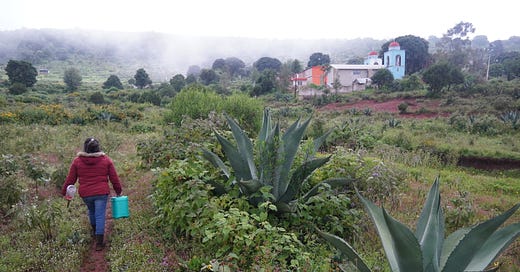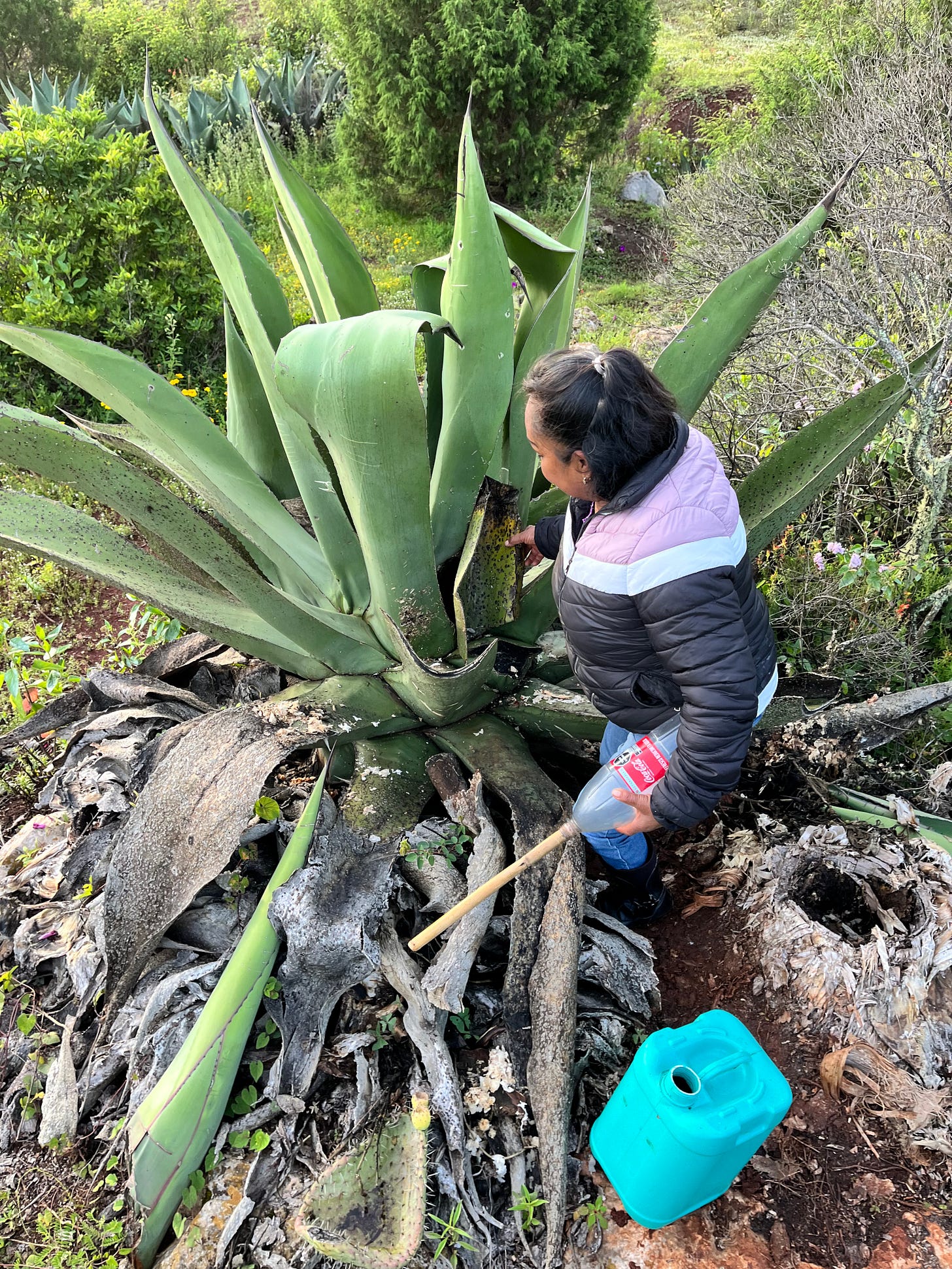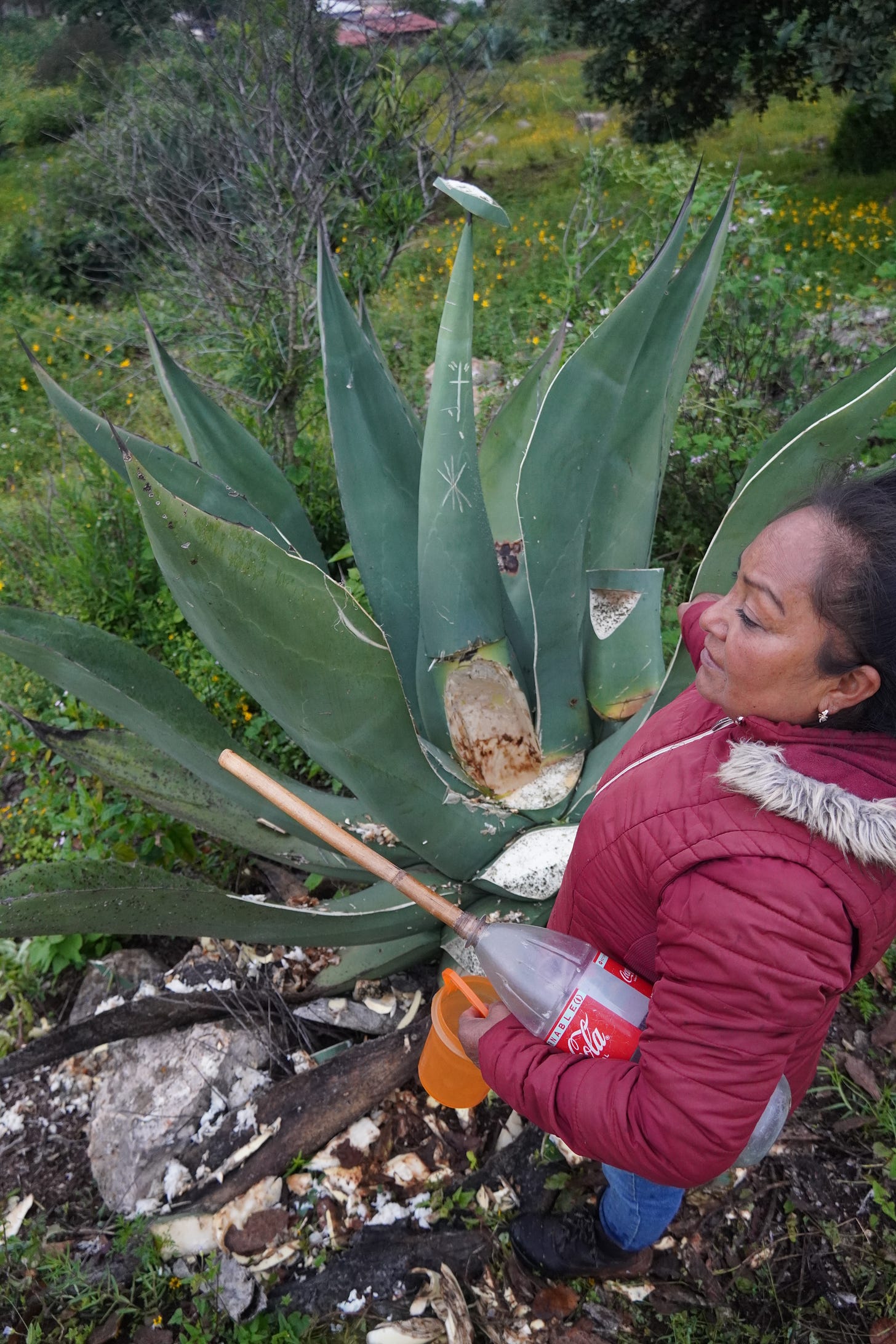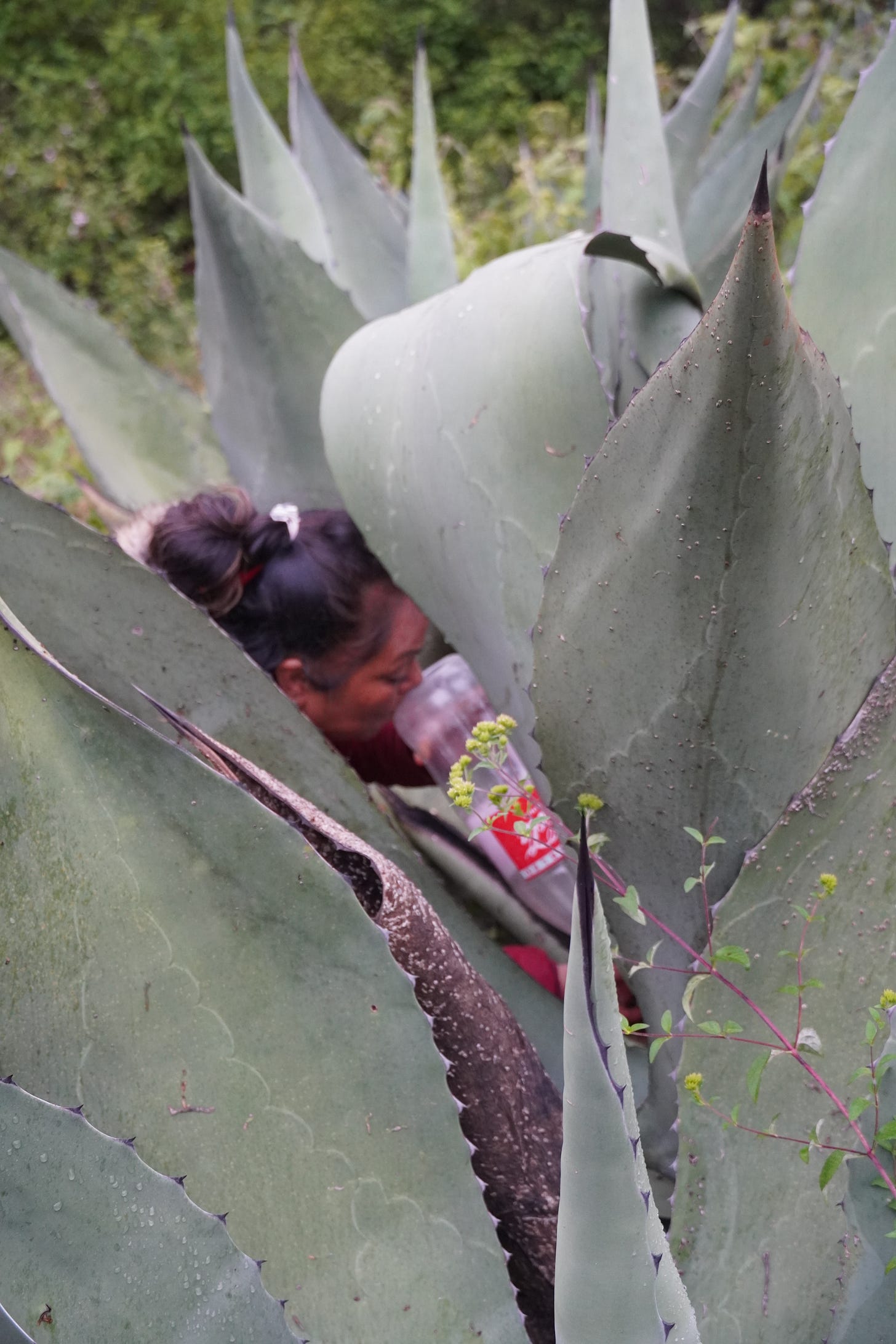Pulque: a fermented agave sap beverage of Mexico.
My visit to see the process of collecting aquamiel, and making pulque in Oaxaca.
Following the tepache post, I want to speak about a second lightly alcoholic beverage made in Mexico that has deep history and cultural significance. This post is based on three days spent in a mountain village above Nochixtlan, in Northern Oaxaca. The family I stayed with are Mixteco, one of the many indigenous/linguistic groups in Oaxaca. They are part of Mujeres Milenarias, a collective of fifty producers of pulque, which is made by fermenting the sap of certain species of agave. Pulque is distinct from mezcal, which involves roasting whole agave cores, transforming starches into sugars which are fermented into alcohol then distilled. For now let’s get acquainted with “the drink of the gods”.
Towards the end of a two hour minibus ride, I was gazing out the window as the mid-morning street life quietly hummed. No matter how much I travel, I am still captivated by seeing the lives of people, as they walk about, shop, sit around and socialize. I had been put in contact with two women who were going to show me around, but the plan was less than clear to me. I just texted a number, running my messages and the responses through google translate since I don’t speak Spanish. After some confusion I meet Alejandra Rodriquez, and hopped in her son’s well-used car. Without delay, he drove us up into the mountains, wet from recent heavy rains. This felt familiar, hoping in cars with strangers whose language I don’t speak, not knowing where we are going. As someone who is a bit obsessed with knowing where I am on the map, taking my hands off the wheel can be challenging. But I have a mantra to calm my mind.
Trust the journey.
If you were supposed to be anywhere else, you’d be there.
Breath in. Breathe out.
There is an origin story that rabbits taught humans how to make pulque. The legend is that humans observed rabbits chewing well-like holes in the base of agave plants, then leaving the well to fill with sap for 3 days before returning to drink the fermented result, causing them to become intoxicated. It turns out that humans are not the only animals that seek to influence their consciousness through the ingestion of “drugs”. There are a plethora of well-documented cases of this, cataloged in a book called Animals and Psychedelics. This also connects to something I have heard mentioned by pastoralists in many parts of the world, that their livestock (especially goats) taught THEM, the herders, the nature of healing plants, because many animals are capable of effectively self-medicating. By observing which plants animals with a given condition gravitated towards, humans were taught which plants could heal corresponding conditions in their herds, and themselves. This is not some far out idea, there’s a whole field of study called Zoopharmacognosy, that looks at this phenomenon.
As Ale took me on an after-lunch stroll up the road, I saw rows of various species and sizes of agaves, that had obviously been planted, or more accurately, transplanted. Others were more spread out and sporadic, and I asked if they were wild. She said no, they were transplanted, and then left with minimal intervention. So these are somewhere in between wild and cultivated, kind of like a lackadaisical orchard. They can take 6 - 20 years to reach maturity, which culminates in the ascension of a tall, tree-like stalk called a quiote. The plant flowers just once in its long life, and prepares for this by producing copious amounts of energy for the finale in the form of a sugary sap referred to as aquamiel. Honey water.
For pulque, Ale says they would observe telltale signs, waiting to remove the core of the plant until just before the quiote shoots up. This is accomplished with axes and the kind of long metal rods that are used to pry boulders loose. A wide, well-like hole is made in the heart of the plant, referred to as the cajete. It then has to sit for 3 - 8 months, before the twice daily harvesting of the aquamiel begins. The plant will produce this sweet liquid for 3 - 6 months, and can generate 1000 liters before its inevitable death.

About 30 minutes before sunset, I went out with Ale to watch her gather the aquamiel. We walked down a path in the slippery red mud that the region is known for, there is even a town called Tierra Colorado just up the road. Red Earth. She carried a small plastic vessel that resembles a gas can, and a coke bottle with a hollow stem of arundo coming out the top, which she uses to suck up the aquamiel that collects in the well-like cajete.
We approached an agave that was taller than me, its massive green arms reaching out like alien tentacles. Some of these had been hacked off to allow safe access to the cajete. Others were pulled back and tied off out of the way. The cajete was covered with hunks of the plant, to keep rain, rodents, and insects out. Ale placed the bamboo-like stem into the well, and sucked on a hole in the coke bottle, pulling the liquid up until a bubbling sound indicated she had emptied the cajete. She then covered the bottom of the stem with her finger, and transferred the liquid to the small plastic can.
The next step is to use a wide, sharp, spoon-like tool called a raspador to scrape the inside of the hole, discarding the resulting pulp. This action encourages the sap to keep flowing, keeping the wound open so the plant keeps pumping sap there in an attempt to heal itself. The cajete is covered again, and we move on to the next plant. She looks strikingly like a hummingbird, as she sticks her head into the plant to suck up the syrupy goodness through her makeshift beak, then dances on to the next plant, methodically drinking up the sacred, life-sustaining elixir. Hummingbirds are in fact an important pollinator of certain agaves, spreading pollen as they go from flower to flower, seeking nectar. Other agaves have flowers that only open at night, and are pollinated almost exclusively by bats and moths. This is one of the reasons agaves produce so much sugar in the first place. To attract the migratory bats, that spread their genetics hundreds of miles, as they move between Mexico and the US. Pulque is predicated on the death of agaves, and the life of bats, hummingbirds, and insects.
I went with Ale to collect aquamiel two more times during my visit, and we followed the same circuit, performed the same ritual. On some of the plants I noticed crosses and sun rays had been carved. The collected liquid is brought back into the kitchen, and strained to remove any plant debris and insects. There was a blue plastic barrel containing finished pulque placed right next to a shrine, that had the typical catholic iconography, along with flowers, all on top of petate mats that are one of many local handicrafts made from palm fibers. We had been drinking out of the barrel liberally, and when someone came to buy pulque she dipped in and filled up empty coke bottles. There was perhaps 3-4 liters remaining in the barrel, and we would pour the 2-3 liters of fresh, sweet aquamiel into the fermented pulque. This resembles continuous brew kombucha, where you remove most of the fermented product and add sweet tea, to keep feeding sugars to the SCOBY that is active in the liquid. I would say it is a kind of mixed fermentation as I defined in my last post, but this family preferred to drink it in its early phase, where it is likely yeasts that are dominant. Like so many ferments, it is about restraint, about holding the process back, not letting it go crazy.
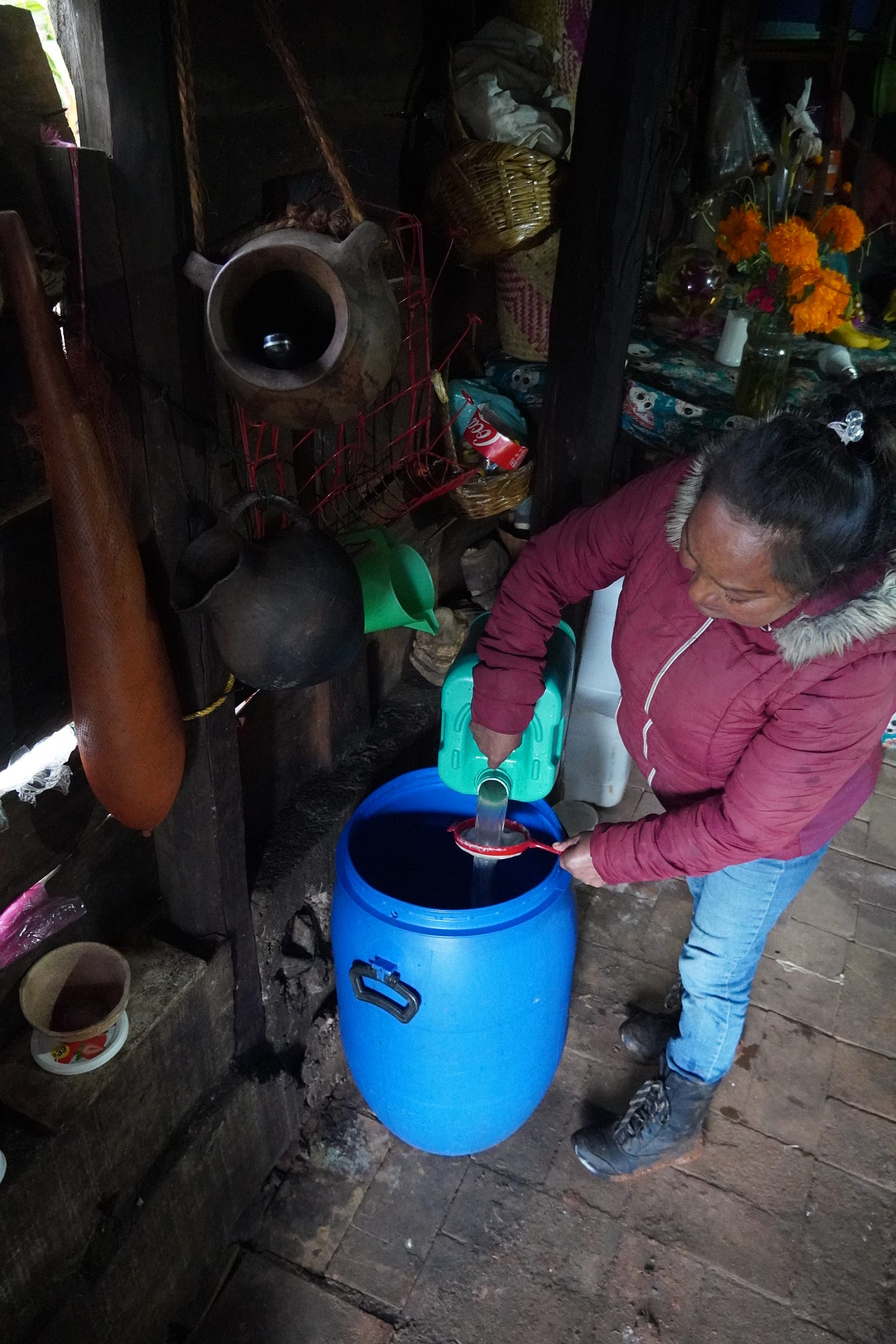
When I visited it was cold and rainy, and very little aquamiel was being offered by the plants. From what I’ve read, the process is different in the summer when there is a high volume of aquamiel each day, and hot temps cause rapid fermentation. I have seen this adaptive approach in many cheeses. Instead of trying to artificially maintain static conditions in the space where cheese is made and aged, standardizing the milk to remove seasonality, many makers shift the process, make different cheeses at different times, and allow seasonality and outside conditions into their process.
I sat in the shed-like kitchen/living room, with a tin roof and gaps in the wood walls to allow breeze in, helping push the smoke from a constant open fire out a hole in the ceiling. My eyes burned, but nobody else seemed bothered. Bowl after bowl of pulque was offered to me. I emptied them all, and felt my body being blessed by the holy mother agave.
Pulque reminds me of milk and natural cheesemaking in a few ways. I heard the family refer to it as “Leche de Mageuy”, milk of agave. It is thick, white, and full of a range of life-boosting sugars. The cajete where it collects is the udder, and like milk, the necessary, healthy microbes are already there, in and on the body of the mother. This diversity of bacteria and yeasts is maintained on the equipment used to ferment, which creates even more healthy byproducts. The culture need not be brought in from outside, it is maintained by the regular repetition of the fermentation.
Aquamiel wants to be Pulque.
All it needs is a vessel, next to a shrine.
Some care, ritual, and human hands.
Tasting notes
Sweet palm wine, hint butterscotch. Diacetyl. Floral honey.
Texture - velvet, buttery, starchy corn water with slight slime + hint of ropy, EPS.
Sour - just starting, light malic + citric. Like a blackberry.
Fruits - coconut, kiwi, apple, pear earthiness. Cactus fruit.
Vegetal - cooked carmelized squash, roast carrots, aloe vera.
Alcohol - 4 - 5% delicate young pear wine. Young saison, yeast flavors of bread, beer, banana.
It is a mixed ferm, with yeast and bacs.
It is preferred to consume while only a few days old, before souring and slime takes hold.

